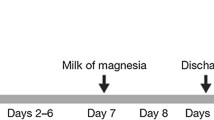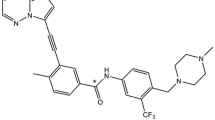Abstract
Purpose
Idasanutlin, a selective small-molecule MDM2 antagonist in phase 3 testing for refractory/relapsed AML, is a non-genotoxic p53 activator with oral administration. To determine the need to conduct dedicated trial(s) for organ impairment on pharmacokinetic (PK) exposure and/or drug–drug interactions, a single dose of [14C]- and [13C]-labeled idasanutlin was evaluated.
Methods
This study was an open-label, non-randomized, single-center trial of idasanutlin to investigate the excretion balance, pharmacokinetics, metabolism, and absolute bioavailability of a single oral dose of [14C]-labeled idasanutlin and an IV tracer dose of [13C]-labeled idasanutlin in a single cohort of patients with solid tumors. After completing cycle 1 assessments, patients could have participated in an optional treatment extension of idasanutlin. Clinical endpoints were PK, and safety/tolerability.
Results
Co-administration of an oral dose of idasanutlin with an IV tracer dose revealed low systemic CL, a moderate Vd, and a moderate (40.1%) absolute bioavailability of idasanutlin. Idasanutlin and its major inactive metabolite, M4, were the major circulating moieties in plasma, and excretion of idasanutlin-associated radioactivity was primarily via the fecal route (91.5% of the dose), with negligible amounts recovered in urine, following oral administration.
Conclusion
The clinical implications of this study support the conclusion that renal impairment is unlikely to significantly impact exposure to idasanutlin and M4 metabolite, whereas a significant hepatic impairment may potentially alter exposure to the parent drug and/or metabolite(s). The potential for drug–drug interactions is low.



Similar content being viewed by others
References
Vassilev LT, Vu BT, Graves B, Carvajal D, Podlaski F, Filipovic Z, Kong N, Kammlott U, Lukacs C, Klein C, Fotouhi N, Liu EA (2004) In vivo activation of the p53 pathway by small-molecule antagonists of MDM2. Science 303:844–848. https://doi.org/10.1126/science.1092472
Ding Q, Zhang Z, Liu JJ, Jiang N, Zhang J, Ross TM, Chu XJ, Bartkovitz D, Podlaski F, Janson C, Tovar C, Filipovic ZM, Higgins B, Glenn K, Packman K, Vassilev LT, Graves B (2013) Discovery of RG7388, a potent and selective p53–MDM2 inhibitor in clinical development. J Med Chem 56(14):5979–5983
Higgins B, Glenn K, Walz A, Tovar C, Filipovic Z, Hussain S, Lee E, Kolinsky K, Tannu S, Adames V, Garrido R, Linn M, Meille C, Heimbrook D, Vassilev L, Packman K (2014) Preclinical optimization of MDM2 antagonist scheduling for cancer treatment by using a model-based approach. Clin Cancer Res 20:3742–3752
Glenn KJ, Yu LJ, Reddy MB, Fretland AJ, Parrott N, Hussain S, Palacios M, Vazvaei F, Zhi J, Tuerck D (2015) Investigating the effect of autoinduction in cynomolgus monkeys of a novel anticancer MDM2 antagonist, idasanutlin, and relevance to humans. Xenobiotica 19:1–10
Siu L, Italiano A, Miller W, Blay J, Gietema J, Bang Y, Mileshkin L, Hirte H, Reckner M, Higgins B, Jukofsky L, Blotner S, Zhi J, Middleton S, Nichols G, Chen L. Phase 1 dose escalation, food effect, and biomarker study of RG7388, a more potent second-generation MDM2 antagonist, in patients (pts) with solid tumors. J Clin Oncol; 2014. In: ASCO annual meeting; May 30–June 3, 2014; Chicago, IL, USA. 2014. p. 5s (suppl; abstr 2535)
Yee K, Martinelli G, Vey N, Dickinson MJ, Seiter K, Assouline S, Drummond M, Yoon S, Kasner M, Lee J, Kelly KR, Blotner S, Higgins B, Middleton S, Nichols G, Chen G, Zhong H, Pierceall WE, Zhi J, Chen L (2014) Phase 1/1b study of RG7388, a potent MDM2 antagonist, in acute myelogenous leukemia (AML) patients (Pts). Blood 124(21):116
Nemunaitis J, Young A, Ejadi S, Miller W, Chen L-C, Nichols G, Blotner S, Vazvaei F, Zhi J, Razak A (2018) Effects of posaconazole (a strong CYP3A4 inhibitor), two new tablet formulations, and food on the pharmacokinetics of idasanutlin, an MDM2 antagonist, in patients with advanced solid tumors. Cancer Chemother Pharmacol 81(3):529–537
Recommendations of the International Commission on Radiological Protection. ICRP Publication 105. Ann ICRP 37(5)
Acknowledgements
The authors would like to acknowledge key contributions from Roche colleagues, investigational site staff, and patient volunteers.
Funding
The study was sponsored by F. Hoffmann-La Roche. The funding sources had no role in the design, analysis, and interpretation of the results, and thus the authors were independent from the funding source.
Author information
Authors and Affiliations
Corresponding author
Ethics declarations
Conflict of interest
LC, SB, FV, RJ, and JZ are employees of Roche. DD was an employee of Rutgers University, through a fellowship grant from Roche.
Additional information
Publisher's Note
Springer Nature remains neutral with regard to jurisdictional claims in published maps and institutional affiliations.
Rights and permissions
About this article
Cite this article
Pápai, Z., Chen, LC., Da Costa, D. et al. A single-center, open-label study investigating the excretion balance, pharmacokinetics, metabolism, and absolute bioavailability of a single oral dose of [14C]-labeled idasanutlin and an intravenous tracer dose of [13C]-labeled idasanutlin in a single cohort of patients with solid tumors. Cancer Chemother Pharmacol 84, 93–103 (2019). https://doi.org/10.1007/s00280-019-03851-0
Received:
Accepted:
Published:
Issue Date:
DOI: https://doi.org/10.1007/s00280-019-03851-0




